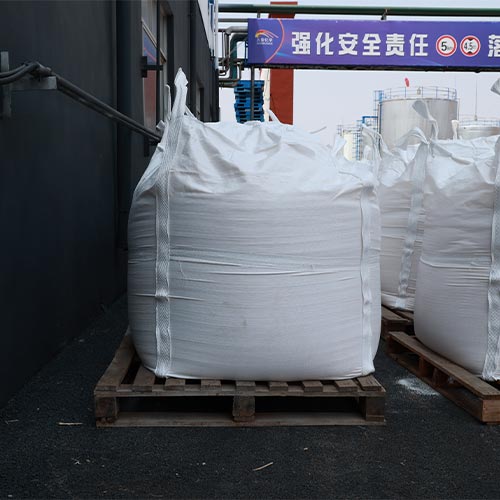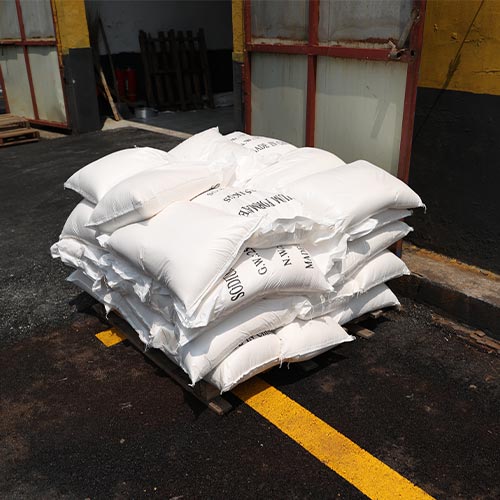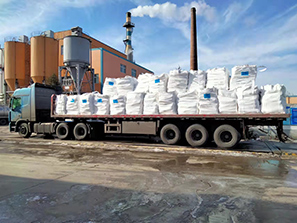Sodium Formate, a versatile compound, has gained popularity in various industries due to its remarkable features and numerous applications. In this article, we will explore the 15 features of Sodium Formate that make it a favorite choice across different sectors.
Introducción a formiato de sodio

Sodium Formate, a versatile compound, is gaining recognition across various industries for its exceptional properties and wide-ranging applications. In this article, we will delve into the world of Sodium Formate, exploring its chemical composition, production process, and the myriad industries where it plays a pivotal role. Sodium Formate, with the chemical formula CHNaO2, is a white crystalline powder, and its unique attributes make it a valuable component in the chemical landscape.
Chemical Composition and Structure
Sodium Formate, a versatile compound with the chemical formula CHNaO2, consists of several key elements. These elements are sodium (Na), carbon (C), hydrogen (H), and oxygen (O).
The structure of Sodium Formate is characterized by the arrangement of these atoms in a specific molecular configuration. Sodium, a metallic element, is bonded with carbon, hydrogen, and oxygen atoms to form a white crystalline powder. This structure is essential to its unique properties and its role in various industrial applications.
formiato de sodio Proceso de producción
The production of Sodium Formate typically involves a chemical reaction between sodium hydroxide (NaOH) and formic acid (HCOOH). This reaction results in the formation of Sodium Formate (HCOONa) along with water as a byproduct. This process can be carried out through various methods, including direct neutralization or by reacting a sodium compound with carbon monoxide under pressure.
The method of production often depends on the specific requirements of the industry and the desired purity of the final product. This process is known for its cost-effectiveness and its relative simplicity, making Sodium Formate an accessible and widely utilized compound across various sectors.
Aplicaciones industriales
Industria del cuero
Sodium Formate is used in the leather industry for tanning hides and skins. It acts as a reducing agent, ensuring high-quality leather production.
Agente descongelante
As a deicing agent, Sodium Formate is effective in melting ice and snow on roads and runways. It is a safer and more eco-friendly alternative to traditional deicers.
Oil Drilling Fluids
In the oil and gas industry, Sodium Formate is employed as a drilling fluid additive, aiding in lubrication and reducing friction during drilling operations.
Food Preservation
Sodium Formate serves as a food preservative, extending the shelf life of products by inhibiting the growth of mold and bacteria.
Beneficios ambientales
Sodium Formate offers several environmental advantages, making it an eco-friendly choice in various applications:
- Biodegradabilidad: Sodium Formate is biodegradable, which means it can naturally break down in the environment over time. This property minimizes its long-term impact on ecosystems.
- Low Environmental Toxicity: Unlike some chemical compounds, Sodium Formate exhibits low toxicity to aquatic life and the environment. Its use does not pose significant risks to the ecosystem.
- Reduced Corrosion: In applications like deicing, Sodium Formate causes less damage to infrastructure and vehicles compared to traditional salt-based deicers, thus reducing the need for costly repairs and maintenance.
- Lower Energy Consumption: When used as a drilling fluid additive, Sodium Formate can help reduce friction during drilling operations. This not only improves efficiency but also results in lower energy consumption, benefiting the environment.
- Sustainable Agriculture: In agriculture, Sodium Formate is used as a pesticide and herbicide, providing an environmentally friendly way to control pests and unwanted vegetation without relying on more harmful chemicals.
Seguridad y Manejo
Sodium Formate is generally safe to handle when proper precautions are followed. Here are some key safety considerations:
- Equipo de proteccion: When working with Sodium Formate, it’s advisable to wear appropriate personal protective equipment (PPE), including gloves and safety goggles, to prevent skin contact and eye irritation.
- Avoid Inhalation: Inhalation of Sodium Formate dust should be avoided. Work in well-ventilated areas or wear a mask when handling the compound to prevent the inhalation of airborne particles.
- Storage: Store Sodium Formate in a cool, dry place away from incompatible materials. Keep it in a tightly sealed container to prevent moisture absorption, which can cause clumping.
- First Aid: In case of skin or eye contact, rinse with plenty of water for several minutes. Seek medical attention if irritation persists. If ingested, seek immediate medical attention and provide relevant product information.
- Spill Response: In the event of a spill, follow appropriate spill containment and cleanup procedures. Avoid creating dust during cleanup.
- Compatibility: Sodium Formate should not be mixed with incompatible substances. Ensure that it is stored away from strong acids and strong oxidizers to prevent potentially hazardous reactions.
- Cumplimiento normativo: Be aware of and comply with local, state, and federal regulations regarding the handling, transportation, and disposal of Sodium Formate.
While Sodium Formate is considered relatively safe to handle when proper precautions are observed, it’s essential to follow safety guidelines and consult safety data sheets (SDS) provided by the manufacturer for specific handling instructions.
formiato de sodio vs. Other Deicing Agents
Sodium Formate stands out as an effective deicing agent, and when compared to traditional deicers, it offers several advantages:
- Lower Freezing Point: Sodium Formate can effectively melt ice and snow at lower temperatures compared to common rock salt (sodium chloride). This means it remains effective even in extremely cold conditions.
- Reduced Environmental Impact: Unlike traditional deicing agents, Sodium Formate is environmentally friendly. It is biodegradable and has a lower environmental impact, as it does not harm aquatic life or soil quality.
- Less Corrosive: Sodium Formate is less corrosive than chloride-based deicers, making it a safer choice for infrastructure, vehicles, and equipment. It reduces the risk of damage and maintenance costs.
- Minimal Residue: Sodium Formate leaves behind less residue on roads and runways, resulting in cleaner surfaces and reduced clean-up efforts.
- Safety: It is considered safe for use around plants, pets, and the environment. Sodium Formate minimizes the risk of harm to pets and wildlife, making it a preferred choice in residential areas.
- Reduced Harm to Concrete: Sodium Formate is less damaging to concrete surfaces compared to traditional deicers, which can lead to the deterioration of concrete structures over time.
- Economical: While Sodium Formate may have a slightly higher upfront cost compared to some deicing agents, its effectiveness at lower temperatures and reduced long-term costs make it a cost-effective choice.
Usos farmacéuticos
Sodium Formate finds application in the pharmaceutical industry due to its versatile properties:
- Buffering Agent: Sodium Formate is used as a buffering agent to maintain the pH levels in various pharmaceutical formulations. It helps stabilize the acidity or alkalinity of solutions, ensuring the effectiveness and safety of drugs.
- pH Regulator: In certain medications, maintaining a specific pH range is critical for drug stability and efficacy. Sodium Formate assists in regulating the pH of these pharmaceutical preparations.
- Chemical Synthesis: Sodium Formate is employed in the chemical synthesis of specific pharmaceutical compounds. It serves as a reducing agent, helping to facilitate chemical reactions in the production of pharmaceutical intermediates and active ingredients.
- Preservative: In some pharmaceutical products, Sodium Formate may function as a preservative, extending the shelf life by inhibiting the growth of microorganisms such as mold and bacteria.
- Injectable Formulations: Sodium Formate may be used in injectable formulations where precise pH control is crucial to prevent irritation at the injection site and ensure the stability of the drug.
formiato de sodio en agricultura

Sodium Formate plays a vital role in agriculture, serving various purposes that benefit crop cultivation and soil management:
- Herbicide: Sodium Formate is used as a herbicide in agriculture to control unwanted vegetation, such as weeds. It provides an effective and sustainable means of managing weed growth without relying on more harmful chemicals.
- Pesticide: It can also function as a pesticide, helping to protect crops from certain pests and insects. Sodium Formate is considered a safer alternative to some conventional pesticides.
- Soil Amendment: Sodium Formate can be used to adjust soil pH levels. It acts as a pH regulator, ensuring that the soil remains within the optimal pH range for specific crops. Proper pH levels are crucial for nutrient availability to plants.
- Fertilizer Additive: In some cases, Sodium Formate is added to fertilizers to enhance their effectiveness. It aids in the controlled release of nutrients, ensuring that plants receive essential elements for growth.
- Reducing Agent: Its reducing properties make Sodium Formate a valuable compound for various chemical processes in agriculture, such as the production of agrochemicals and the synthesis of specific organic compounds.
- Environmental Considerations: Sodium Formate’s eco-friendly nature is also advantageous in agriculture, as it minimizes harm to the environment and reduces the ecological impact of agricultural practices.
Sodium Formate as a Reducing Agent
Sodium Formate exhibits excellent reducing properties, making it a valuable compound in various chemical processes:
- Reduction of Metal Salts: Sodium Formate is commonly used to reduce metal salts to their respective metal forms. This reduction reaction is essential in the production of metals and metal alloys.
- Catalyst in Reduction Reactions: It serves as a catalyst in reduction reactions, where it helps facilitate the transfer of electrons. This catalytic activity is vital in chemical processes such as the reduction of nitro compounds to amines.
- Deoxygenation: Sodium Formate can be employed to remove oxygen from certain chemical reactions or solutions. This is particularly useful in environments where the presence of oxygen can interfere with the desired chemical transformations.
- Hydrogen Production: In some cases, Sodium Formate can be used to generate hydrogen gas, a versatile and clean energy source. The production of hydrogen through the dehydrogenation of Sodium Formate has potential applications in fuel cell technology.
- Chemical Synthesis: Sodium Formate’s reducing properties play a significant role in the synthesis of various organic compounds, including pharmaceutical intermediates and specialty chemicals.
formiato de sodio in Textile Industry
Sodium Formate is a versatile compound with several applications in the textile industry, where it plays a crucial role in various processes:
- Dyeing and Printing: Sodium Formate is used as a reducing agent in textile dyeing and printing. It helps to fix dyes on the fabric, ensuring vibrant and uniform coloration. This is especially important for achieving consistent and brilliant color results in textile products.
- Color Fastness: Sodium Formate aids in enhancing the color fastness of textiles. It contributes to the fabric’s ability to retain its color when exposed to environmental factors such as light, water, and abrasion.
- Reducing Agent: Its reducing properties are beneficial in textile processes that involve the reduction of chemical compounds. This ensures the proper chemical reactions take place during the dyeing and finishing of textiles.
- Eco-Friendly Dyeing: Sodium Formate is considered an eco-friendly option in textile dyeing. Its reduced environmental impact and lower toxicity make it a preferred choice for textile manufacturers aiming to adopt more sustainable practices.
- Consistency and Quality: By using Sodium Formate as a reducing agent, textile manufacturers can achieve greater consistency in color and quality across their products. This leads to higher customer satisfaction and brand reputation.
Pulp and Paper Industry Applications
Sodium Formate serves various important roles in the pulp and paper industry, contributing to the efficiency and quality of paper production:
- Pulping Process: Sodium Formate is used as a chemical additive in the pulping process. It aids in breaking down wood fibers and dissolving lignin, making it easier to separate the pulp from the wood chips. This results in higher pulp yield and improved paper quality.
- Bleaching: In the bleaching of pulp, Sodium Formate is employed to help control pH levels. Proper pH regulation is essential for achieving the desired brightness and color in the final paper product.
- Paper Sizing: Sodium Formate can be used as a sizing agent in paper production. Sizing agents are applied to paper to control its ink absorption and improve printability, which is crucial for achieving high-quality printed materials.
- Controlling Hardness: Sodium Formate can help control water hardness in the pulp and paper industry. Managing water hardness is essential to prevent the buildup of scale and improve the efficiency of various processes.
- Reduction of Environmental Impact: Sodium Formate’s biodegradability and reduced environmental toxicity make it a favorable choice for the pulp and paper industry, aligning with the industry’s efforts to adopt more eco-friendly practices.
- Improved Product Quality: By using Sodium Formate, paper manufacturers can enhance the quality of their products, ensuring a smoother production process and producing paper with desired characteristics.
formiato de sodio in Dyeing Processes
Sodium Formate plays a significant role in dyeing processes, particularly in the textile and related industries, where it contributes to achieving vibrant and uniform coloration:
- Dye Fixative: Sodium Formate is employed as a dye fixative. It helps in the fixation of dyes on the fabric, ensuring that the color adheres to the textile fibers effectively. This is crucial for achieving consistent and long-lasting color results.
- Reduction Agent: Its reducing properties make Sodium Formate valuable in dyeing processes. It assists in the reduction of certain dye compounds, ensuring that the dyes properly bond with the fabric and maintain their colorfastness.
- Even Coloration: Sodium Formate helps in achieving even coloration across the fabric. It ensures that the dye penetrates the textile material uniformly, preventing splotches or uneven coloring.
- Optimal pH Control: Proper pH control in dyeing processes is essential for color development and adherence. Sodium Formate can be used as a pH regulator to maintain the pH levels within the desired range for specific dyes.
- Sustainable Dyeing: Sodium Formate is favored by textile manufacturers who aim to adopt sustainable and environmentally friendly dyeing practices. Its reduced environmental impact and biodegradability align with the industry’s increasing emphasis on eco-conscious production.
Conclusión
Sodium Formate’s versatility and unique properties have made it an essential compound in various industries, from leather and textiles to pharmaceuticals and agriculture. Its eco-friendly nature and safety make it a favorite among professionals in these fields.
Now, let’s address some common questions about Sodium Formate.
preguntas frecuentes
Es formiato de sodio safe for the environment?
Yes, Sodium Formate is environmentally friendly and biodegradable, making it a safe choice for various applications.
How is Sodium Formate different from traditional deicing salts?
Sodium Formate is more effective at lower temperatures and is less harmful to the environment compared to traditional deicing salts.
Can Sodium Formate be used in the food industry?
Certainly, Sodium Formate is used as a food preservative to extend the shelf life of products.
What are the safety precautions for handling Sodium Formate?
While it is generally safe, handling Sodium Formate should follow standard safety protocols to avoid any potential risks.
Where can I find Sodium Formate products?
Sodium Formate products are available through various chemical suppliers and are commonly used in industries worldwide.



